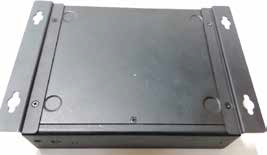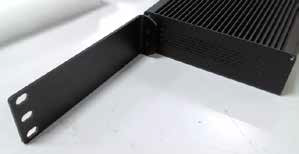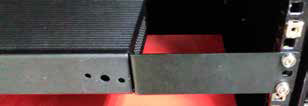| Include Page | ||||
|---|---|---|---|---|
|
| Hide_comments |
|---|
...
Reqiered tools
Screwdriwer set.
Pliers / pipe wrench.
Wrench set.
Additional equipment
- GPS receiver.
- High magnification binoculars.
| Warning | ||
|---|---|---|
| ||
Before mounting the equipment in an outdoor environment, please make sure that:
|
Installation Procedure
In case of device with external antenna. Prepare RF cables of the required length, recommended maximal length is 1 meter. Install and isolate the connectors on the RF cable.
Warning title CAUTION In order to prevent device damage make sure that antenna is connected to both N-type connectors with serviceable RF cables before switching on.
- Install ODU connector facing down using the mounting kit. Do not tighten the fasteners to the end until the alignment is completed.
- Connect the Cat5e FTP cable with the cable gland to ODU.
- Perform ODU grounding.
- Lay the Cat5e FTP cable from ODU to the power supply.
Connect the Cat5e FTP cable with a shielded connector covered by a cap to the "OUT" port of the power supply, having previously touched the power supply connector case with FTP cable connector case.
Warning title CAUTION The power supply must not operate near a direct heat source, near water or in an environment with high humidity. The cables must be connected in such a way to prevent water flow to the power supply connectors.
- Perform the power supply grounding.
- Connect the laptop using Cat5e FTP cable to the power supply "IN" port.
Connect the power cord to the power supply and then to the power circuit.
Warning title CAUTION Use mains supply cords that adhere to safety regulations of the country where the equipment is getting deployed.
Make sure a small loop (at least 10 cable diameters) is provided before the Cat5e FTP cable enter into the building.
| Center |
|---|
...
| title | CAUTION |
|---|
Please note that the pressure equalization system in Infinet devices is performed via gas exchange through a cable gland and Ethernet cable jacket with a dry room where the power supply is installed. In order to avoid ODU failure due to moisture entering the device, for example, during the pressure drop during the rain, the cable gland assembly requirements should be met and there are should be no cracks in the Ethernet cable jacket.
...
Before starting operation, the following must be performed:
- Unnpacking.
- Hardware platform installation.
- Power adapter connection.
- Connecting to the end nodes.
- Device configuring.
Unpacking
Open the box and carefully remove its contents. Check for all components and make sure they are not damaged. The delivery set list is given in the "Packing List" section. If something is missing or damaged, you must contact the distributor through which you purchased the device, or, if you purchased the device directly from Infinet, send a request to the technical support service: support@infinet.ru.
Hardware platform installation
The surface on which the devices is installed must support the device and power adapter weight. There must be enough space around the device for air flow and free access to the cable connectors: at least 15 cm on the side of the power adapter connection, cables and ventilation fins, and 5 cm on the other two sides. The operating temperature and humidity values must be within the permissible limits at the installation site of the device.
Desktop installation
When installing the device on a table or any surface to prevent moving, it is recommended to use mounted headers supplied by default.
Wall installation
The device can be mounted on the wall by using optional wallmounting brackets (is not supplied by default). In order to install on the wall the following must be performed:
- Prepare wallmountig brackets.
- Align the brackets on each screw hole on the bottom of the device.
- Insert screws to secure the brackets.
- Place the device on where it will be mounted on the wall. You may draw marks for the circled screw holes for applying wall anchors in later steps. Do the same for both sides.
- Apply the 4 wall anchors designated in the last step. You must have a drilling machine to perform this step. Then, insert threaded nails into the anchors. Do NOT insert the nails totally into the anchor. Leave a tiny gap enough to hang the wallmounting bracket.
- Hang the device onto the wall. Remember to match the brackets’ 4 screw holes with the 4 threaded nails on the wall. You may screw the nails tighter after you hang the device.
Rack installation
The device can be mounted on a rack using L-shaped rackmounting brackets (is not supplied by default). Before installation please read the precautions first.
- Elevated Operating Ambient. If installed in a closed or multi-unit rack assembly, the operating ambient temperature of the rack environment may be greater than room ambient. Therefore, consideration should be given to installing the equipment in an environment compatible with the maximum ambient temperature specified by the manufacturer.
- Reduced Air Flow. Installation of the equipment in a rack should be such that the amount of air flow required for safe operation of the equipment is not compromised. Mechanical Loading: mounting of the equipment in the rack should be such that a hazardous condition is not created due to uneven mechanical loading.
- Circuit Overloading. Consideration should be given to the connection of the equipment to the supply circuit and the effect that overloading of the circuits might have on over-current protection and supply wiring. Appropriate consideration of equipment nameplate ratings should be used when addressing this concern.
- Reliable Grounding. Reliable grounding of rack-mounted equipment should be maintained. Particular attention should be given to supply connections other than direct connections to the branch circuit.
| Note | ||
|---|---|---|
| ||
Slide/rail mounted equipment is not to be used as a shelf or a work space. |
After reading the precautions, please see the following for mounting on a rack:
- Prepare the L-shaped rackmounting brackets.
- Attach the L-shaped brackets to the screw holes on eachside of the device. Apply screws to secure the brackets until totally fixed.
- Attach the ears of the L-shaped brackets to the rack and then apply long threaded nails. Repeat this for another side.
Power adapter connection
The InfiMUX 6G can be connected to the power adapter with a voltage of 100 ... 240 V with a frequency of 50 ... 60 Hz. After switching on, the power indicator on the device should turn green. In the event of a power failure, the device must be switched off. After the power is restored, turn it on again.
Connecting to the end nodes
The PC can be connected to the first Ethernet port with an FTP Cat5e cable, or to the console port with a console cable. The Infinet devices can be connected to the Ethernet ports with an FTP Cat5e cables.



